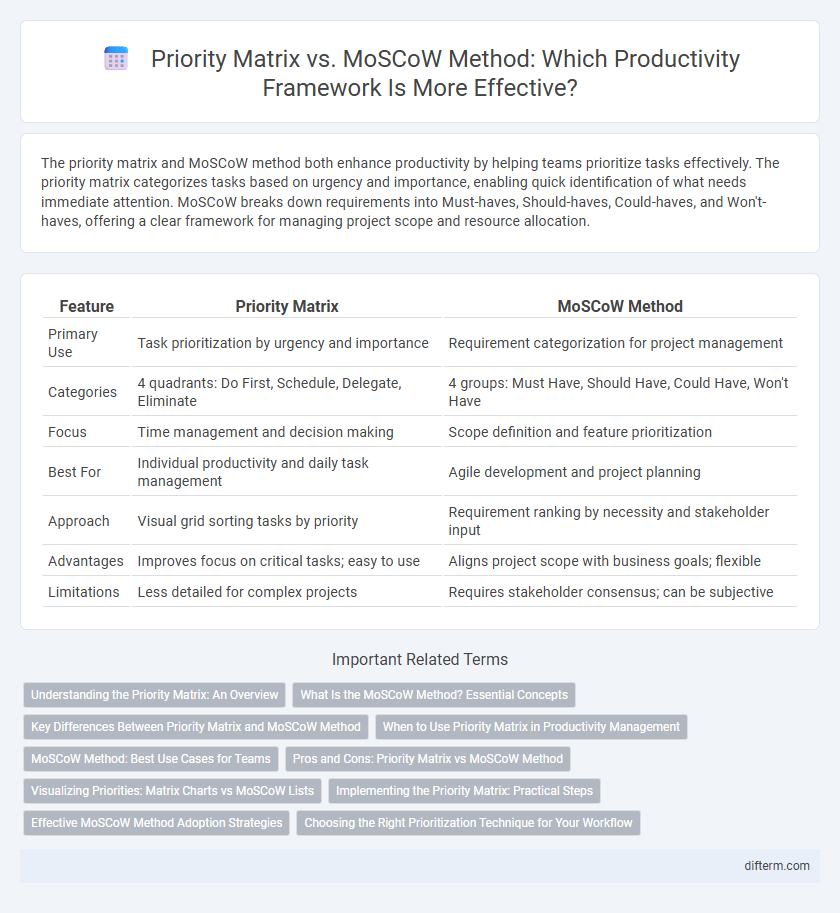The priority matrix and MoSCoW method both enhance productivity by helping teams prioritize tasks effectively. The priority matrix categorizes tasks based on urgency and importance, enabling quick identification of what needs immediate attention. MoSCoW breaks down requirements into Must-haves, Should-haves, Could-haves, and Won't-haves, offering a clear framework for managing project scope and resource allocation.
Table of Comparison
| Feature | Priority Matrix | MoSCoW Method |
|---|---|---|
| Primary Use | Task prioritization by urgency and importance | Requirement categorization for project management |
| Categories | 4 quadrants: Do First, Schedule, Delegate, Eliminate | 4 groups: Must Have, Should Have, Could Have, Won't Have |
| Focus | Time management and decision making | Scope definition and feature prioritization |
| Best For | Individual productivity and daily task management | Agile development and project planning |
| Approach | Visual grid sorting tasks by priority | Requirement ranking by necessity and stakeholder input |
| Advantages | Improves focus on critical tasks; easy to use | Aligns project scope with business goals; flexible |
| Limitations | Less detailed for complex projects | Requires stakeholder consensus; can be subjective |
Understanding the Priority Matrix: An Overview
The Priority Matrix categorizes tasks based on urgency and importance, enabling users to focus on high-impact activities first, while MoSCoW method segments requirements into Must, Should, Could, and Won't have, emphasizing stakeholder negotiation and project scope clarity. Understanding the Priority Matrix enhances decision-making by visually mapping tasks into four quadrants: Do First, Schedule, Delegate, and Eliminate, which streamlines task management. This tool improves productivity by helping individuals and teams prioritize work efficiently, reduce time spent on low-value activities, and maintain alignment with strategic goals.
What Is the MoSCoW Method? Essential Concepts
The MoSCoW method is a prioritization technique used to categorize tasks or requirements into Must have, Should have, Could have, and Won't have, enabling clearer focus on critical deliverables. Unlike the priority matrix, which assesses tasks based on urgency and impact, MoSCoW emphasizes stakeholder agreement and necessity for project success. This method improves project management by aligning resources with essential needs while managing scope and expectations effectively.
Key Differences Between Priority Matrix and MoSCoW Method
The priority matrix categorizes tasks based on urgency and importance, creating four quadrants to help allocate resources effectively, while the MoSCoW method classifies requirements into Must have, Should have, Could have, and Won't have to prioritize features or tasks. The priority matrix emphasizes time management and decision-making by visual positioning, whereas MoSCoW focuses on stakeholder agreement and project scope clarity. Unlike the MoSCoW method, the priority matrix offers dynamic re-prioritization, making it better suited for ongoing task adjustments in productivity workflows.
When to Use Priority Matrix in Productivity Management
Priority Matrix excels in productivity management when tasks require visual organization based on urgency and importance, facilitating quick decision-making. Use Priority Matrix for balancing workload, minimizing stress, and improving focus by categorizing tasks into four quadrants: urgent-important, not urgent-important, urgent-not important, and not urgent-not important. It is particularly effective in time-sensitive projects where prioritizing actionable tasks enhances overall productivity and goal achievement.
MoSCoW Method: Best Use Cases for Teams
The MoSCoW Method excels in prioritizing project requirements by categorizing tasks into Must have, Should have, Could have, and Won't have, making it ideal for agile teams managing evolving workloads. This approach enhances clarity and alignment by focusing team efforts on critical deliverables, ensuring efficient resource allocation and timely project delivery. Its flexible structure supports dynamic project environments where stakeholder priorities frequently shift, fostering collaboration and rapid decision-making.
Pros and Cons: Priority Matrix vs MoSCoW Method
The Priority Matrix offers a visual framework that categorizes tasks by urgency and importance, facilitating quick decision-making but can be subjective and may oversimplify complex projects. The MoSCoW Method distinctly classifies requirements into Must, Should, Could, and Won't have, enhancing clarity in stakeholder communication, yet it may lead to rigid prioritization and overlook task interdependencies. Both techniques improve productivity through focused task management but vary in flexibility and suitability depending on project complexity and team dynamics.
Visualizing Priorities: Matrix Charts vs MoSCoW Lists
Priority matrix charts enable clear visualization of tasks by categorizing them into quadrants based on urgency and importance, enhancing decision-making efficiency. MoSCoW lists organize tasks into Must, Should, Could, and Won't categories, providing a straightforward, categorical priority ranking without spatial context. Matrix charts offer a dynamic overview, aiding in balancing workload, while MoSCoW lists simplify prioritization with explicit labels but lack visual emphasis on task relationships.
Implementing the Priority Matrix: Practical Steps
Implementing the Priority Matrix involves categorizing tasks based on their urgency and importance, typically using four quadrants: urgent and important, important but not urgent, urgent but not important, and neither urgent nor important. This visual framework enables teams to focus on critical activities that drive outcomes, enhancing decision-making compared to the MoSCoW method's categorical prioritization of Must, Should, Could, and Won't. Optimal use of the Priority Matrix includes regular review sessions, clear criteria for task classification, and alignment with organizational goals to boost productivity and resource allocation.
Effective MoSCoW Method Adoption Strategies
Effective MoSCoW method adoption strategies emphasize clear stakeholder alignment on Must-have, Should-have, Could-have, and Won't-have requirements to enhance project prioritization. Integrating the MoSCoW method with the Priority Matrix aids in visualizing task urgency and importance, optimizing resource allocation. Regularly reviewing and adjusting priorities based on project feedback ensures sustained productivity and goal achievement.
Choosing the Right Prioritization Technique for Your Workflow
The Priority Matrix organizes tasks by urgency and importance, enabling clear visualization of what to address first based on impact and deadlines. The MoSCoW method categorizes activities into Must-have, Should-have, Could-have, and Won't-have, emphasizing stakeholder needs and feature prioritization. Selecting the right technique depends on your workflow's complexity, project scope, and whether you require a time-sensitive or requirement-focused approach for maximum productivity.
priority matrix vs MoSCoW method Infographic

 difterm.com
difterm.com